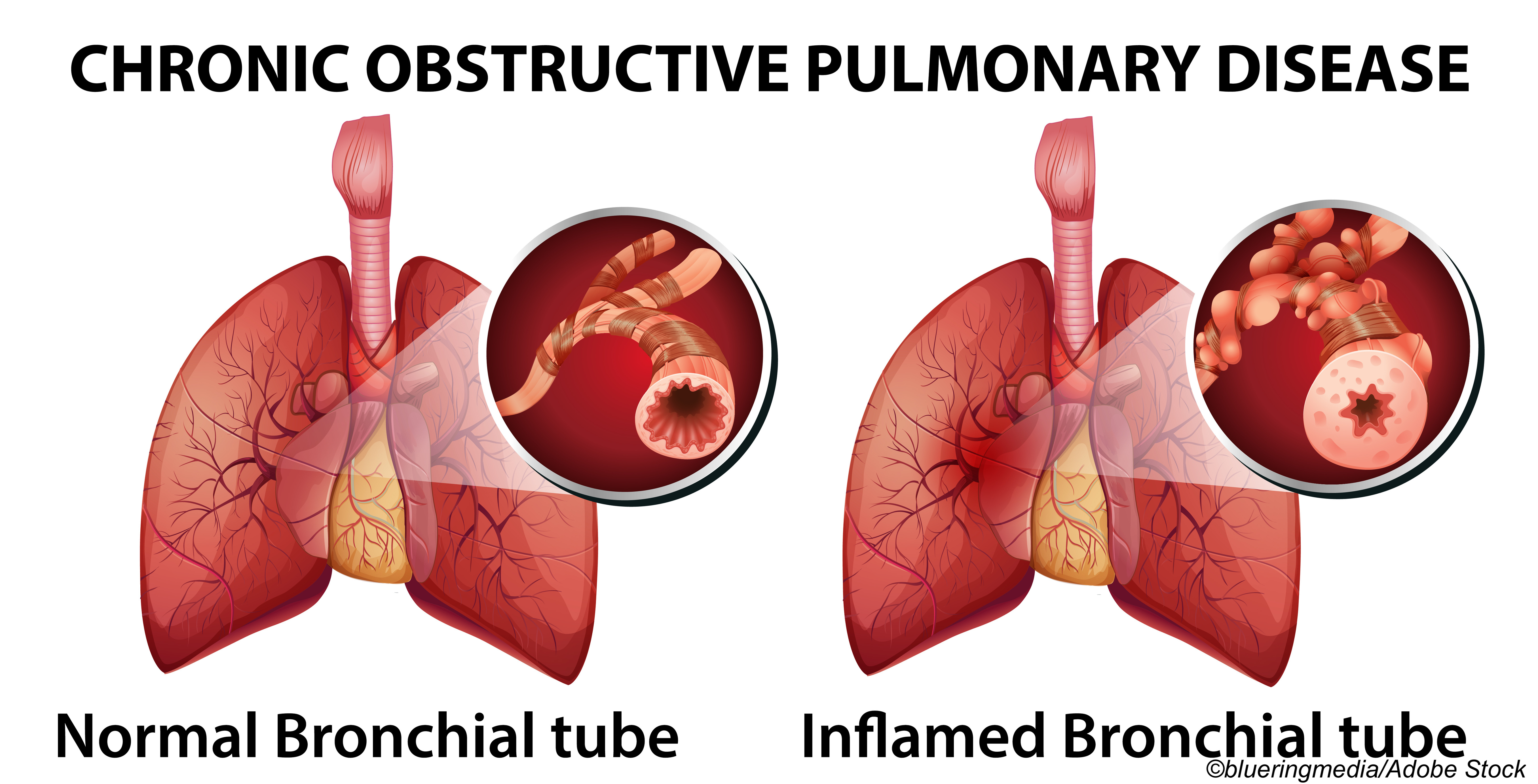In patients with moderate to very severe COPD, fixed-dose, triple-combination treatment with budesonide/glycopyrrolate/formoterol fumarate (Breztri Aerosphere) was found to reduce COPD exacerbations requiring systemic corticosteroids, compared to dual therapies, in post hoc analysis of data from the pivotal ETHOS study.
COPD patients on the metered-dose inhaler triple therapy had significantly fewer exacerbations requiring systemic corticosteroids during the 52-week trial, compared to patients on dual medication therapies, and they also had fewer cumulative days of oral corticosteroid use for moderate exacerbations.
Bartolomé R. Celli, MD, of Harvard Medical School and colleagues reported findings from the ETHOS post hoc analysis in a poster presentation at CHEST 2021, held in Orlando, Florida and online, along with other breaking COPD research.
The fixed dose budesonide/glycopyrrolate/formoterol fumarate (BGF) treatment was approved by the FDA for the maintenance treatment of COPD in the summer of 2020, based on phase III findings from the ETHOS trial, which compared two dose levels of twice daily BGF (320 μg or 160 μg of budesonide) to one of two dual treatments—18 μg of glycopyrrolate plus 9.6 μg of formoterol and 320 μg of budesonide plus 9.6 μg of formoterol.
Initial trial results showed treatment with the triple therapy to be associated with a lower rate of moderate-to-severe exacerbation than treatment with either of the dual therapies.
The post hoc analysis presented at CHEST 2021 investigated exacerbation rates among ETHOS participants requiring systemic corticosteroids and the duration of oral corticosteroid use over the course of the study.
The modified intention-to-treat (mITT) population included 2,137 patients in the BGF-treatment group, 2,120 patients in the glycopyrrolate plus formoterol (GFF) group, and 2,131 patients in the budesonide plus formoterol (BFF ) group.
Across treatment groups, the mean patient age was 65 years, around 43% of patients had one moderate or severe exacerbation during the prior year, and 56% of patients had two or more moderate or severe exacerbations during the prior year. Four-out-of-five (80%) patients were using inhaled corticosteroids at the time of screening and roughly 42% were current smokers at the time of screening. Mean post-bronchodilator FEV1 (% of the predicted normal value) was 43%–44% across treatment groups.
During the year-long study a total of 1,539 moderate or severe exacerbations occurred among 897 BGF-treated patients requiring systemic corticosteroids, compared to 1,837 exacerbations requiring systemic corticosteroid (950 patients) and 1,729 events (954 patients) in the GFF and BFF groups, respectively.
The rate of moderate or severe exacerbations treated with systemic corticosteroids per year was lower among those receiving BGF versus those treated with GFF (aRR, 0.71; 95% CI, 0.64–0.78]; P<0.0001) or BFF (aRR, 0.84; 95% CI, 0.76–0.93; P=0.0009).
The total number of days during the study year with a moderate exacerbation treated with oral corticosteroids with or without antibiotics was 20.9 in the BGF group, versus 30.0 and 23.2, respectively, in the GFF and BFF groups
Study limitations cited by the researchers include the lack of adjustment for multiplicity, and the lack of power for statistical comparisons of the number of days on oral corticosteroids.
Results from the retrospective PRIMUS study, also presented in a poster session at CHEST 2021, suggest that delaying treatment with triple therapy consisting of inhaled corticosteroid, long-acting beta agonist (LABA), and long-acting muscarinic antagonist (LAMA) after a single severe exacerbation or two or more moderate COPD exacerbations increased the risk for subsequent exacerbations, as well as overall health care costs.
Researchers Joseph Tkacz, MS, of IBM Watson Health, Cambridge, Massachusetts, and colleagues, noted that while treatment guidelines recommend stepping up treatment from dual therapy to triple therapy with an ICS/LABA/LAMA after multiple moderate or a single severe exacerbation, the impact of delaying triple treatment after these events is not widely understood.
Their analysis of health care claims data involved 24,770 patients with COPD exacerbations, including 31% who had prompt triple therapy following a qualifying event, 39% who had delayed triple therapy (greater than 30 days to 180 days following an event), and 30% had very delayed triple therapy (beginning 181 days to 1 year following a qualifying event).
The mean time to triple therapy initiation was 119.7 days, and the analysis revealed that post-index exacerbation frequency increased as time to triple therapy increased.
Each 30-day delay of triple therapy was associated with:
- A 10%-12% increased odds of any exacerbation.
- A 7% increased odds of a severe exacerbation.
- A 4.3% increase in number of exacerbations.
- 1.8% and 2.1% increases in all-cause and COPD-related costs.
Total adjusted mean healthcare costs during the year after the index exacerbation related to COPD was several thousand dollars less among patients who experienced no delay in initiating triple therapy than among those who waited a year after experiencing the qualifying exacerbation.
Study limitations cited by the researchers included the reliance on claims data, which is subject to coding error misclassification, and the possibility that patients were initiated on triple therapy based on symptom severity not captured in the data.
-
In patients with moderate to very severe COPD, fixed-dose, triple-combination treatment with budesonide/glycopyrrolate/formoterol fumarate was found to reduce COPD exacerbations requiring systemic corticosteroids, compared to dual therapies, in post hoc analysis of data from the pivotal ETHOS study.
-
Results from the retrospective PRIMUS study suggest that delaying treatment with triple therapy after a single severe exacerbation or two or more moderate COPD exacerbations increases the risk for subsequent exacerbations, as well as overall health care costs.
Salynn Boyles, Contributing Writer, BreakingMED™
The ETHOS and PRIUM studies was funded by AstraZeneca. Researcher Bartolomé Celli reported receiving compensation for advisory boards and consultation fees from AstraZeneca, Boehringer Ingelheim, Chiesi, GlaxoSmithKline, Menarini, Novartis, Pulmonx, Sanofi Aventis. In the PRIUS study, Joseph Tkacz was employed by IBM Watson Health at the time of the study. Several researchers also reported being employees of or paid consultants of AstraZeneca.
Cat ID: 154
Topic ID: 89,154,730,143,192,154,195,225,925,224



